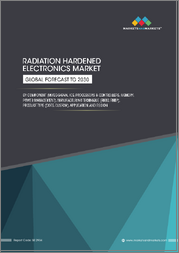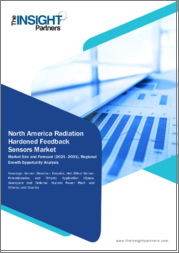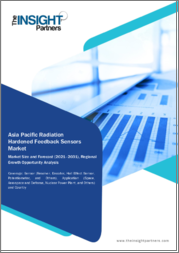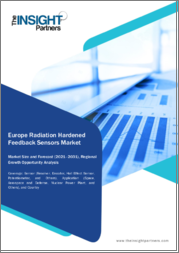
|
시장보고서
상품코드
1625301
세계의 방사선 경화 일렉트로닉스 및 반도체 시장 예측(-2030년) : 컴포넌트별, 기술별, 용도별, 최종 사용자별, 지역별 분석Radiation Hardened Electronics and Semiconductors Market Forecasts to 2030 - Global Analysis By Component (Semiconductors, Passive Components and Other Components), Technology, Application, End User and By Geography |
||||||
Stratistics MRC에 따르면 방사선 경화 일렉트로닉스 및 반도체 세계 시장은 2024년에 18억 달러를 차지하고 예측 기간 동안 CAGR 7.7%로 성장하고 2030년에는 28억 달러에 이를 것으로 예측됩니다.
방사선 경화 일렉트로닉스 및 반도체는 우주선 및 태양 방사선과 같은 표준 전자 장치에 물리적 손상이나 오작동을 일으킬 수 있는 방사선의 유해한 영향을 견디도록 설계되었습니다. 이러한 장치는 우주 개발, 원자력 발전소, 군사 활동, 고도 비행 등의 응용 분야에서 매우 중요합니다.
위성산업협회에 따르면 약 7,316기의 활동 중인 위성이 지구를 주회하고 있어 전년대비 51% 증가, 지난 5년간 321% 증가했습니다.
우주 탐사 활동의 활성화
우주 탐사가 진행됨에 따라 높은 방사선 수준을 견디는 내방사선 부품 수요가 높아지고 있습니다. 우주선 및 기타 우주현상을 견디는 신뢰성이 높은 전자기기를 필요로 하고 있습니다. 시장 성장을 가속하고 있습니다.
방사선 경화 부품의 고비용
방사선 경화 반도체의 비용이 높은 것은 소규모 조직이나 신흥 기업이 우주 탐사나 방위 분야에 진입하는 방해가 될 가능성이 있습니다. 제조업체와 항공우주 제조업체는 필요한 구성 요소를 구입하는 데 어려움을 겪을 수 있습니다. 또한, 부품 비용 증가는 예산이 제한된 정부와 민간 우주 프로그램에 미션 감소, 페이로드 축소, 프로젝트 지연으로 이어질 수 있으며, 그 결과 과학 연구 및 탐사 예산이 더 제한되어 시장을 방해합니다.
기술 진보와 소형화
반도체 재료, 제조 기술, 회로 설계의 진보에 의해 내방사선 컴포넌트의 성능은 대폭 향상되었습니다. 그 결과적으로 고성능화, 에너지 소비량 감소, 열 관리 개선이 이루어지고 있습니다. 소형화도 성능 향상에 기여하고 있습니다. 그리고 시장을 강화하고 있습니다.
고성능화의 과제
내방사선 일렉트로닉스의 고성능화에는 소비 전력 증가, 폼 팩터의 대형화, 발열량 증가 등의 트레이드 오프가 수반되는 경우가 많고, 우주 용도에서는 어려움이 수반됩니다. 등 가혹한 조건과 고성능 요구사항의 균형을 맞추는 것은 복잡한 과제가 됩니다.
COVID-19의 영향
우주 및 방위 분야에서 공급망의 혼란, 생산 지연, 프로젝트 후퇴. 히비키를 줬습니다만, 팬데믹은 첨단 기술의 채용을 가속화해, 우주 탐사와 방어에 대한 투자를 촉구해, 신뢰성이 높고 내구성이 있는 부품에 수요가 견조하게 추이했기 때문에 시장에 장기적 성장 기회를 가져왔습니다.
예측 기간 동안 반도체 부문이 최대가 될 전망
예측기간 중 우주공간, 원자력발전소, 군용도 등 전리방사선이 많은 환경하에서의 기능 신뢰성에 의해 반도체 분야가 최대 시장 점유율을 기록할 것으로 예측됩니다. 인공 위성, 항공우주 시스템에 매우 중요하며, 사선 피폭에 의한 고장은 미션의 실패, 데이터 유출, 시스템 열화로 이어질 가능성이 있습니다. 디자인, 프로세스가 필요합니다.
예측 기간 동안 총 선량 방사선 경화 분야의 CAGR이 가장 높을 것으로 예상됩니다.
우주 미션, 위성 운용, 전리 방사선에 노출되는 군사 시스템 증가로 총 선량 방사선 경화 분야는 예측 기간 동안 유리한 성장을 기록할 것으로 예상됩니다. 된 방사선에 의한 성능 열화를 방지하기 위해 전선량 방사선 경화 컴포넌트가 필요합니다. 하고 있습니다.
최대 점유율을 차지하는 지역:
예측 기간 동안, 우주 탐사, 위성 통신, 우주 인프라 개발의 세계적인 리더인 미국에 의해 북미가 최대 시장 점유율을 획득할 전망입니다. 신뢰성과 내구성이 뛰어난 부품이 필요합니다. 장시간 노출에 견딜 수 있는 방사선 경화 컴포넌트가 필요합니다. 의존합니다.
CAGR이 가장 높은 지역:
아시아태평양은 TSMC, Samsung Electronics, Intel 등 선진적인 주조소를 갖고 세계 반도체 제조를 선도하고 있기 때문에 예측기간 중 가장 높은 CAGR로 성장할 것으로 예상됩니다. 우주 분야에서 내 방사선 전자 제품 중요해짐에 따라, 이들 국가들은 내방사선 컴포넌트의 개발과 제조에 투자하고 있습니다. 이 지역 시장 성장을 뒷받침하고 있습니다.
무료 주문을 받아서 만드는 서비스:
이 보고서를 구독하는 고객은 다음 무료 맞춤설정 옵션 중 하나를 사용할 수 있습니다.
- 기업 프로파일
- 추가 시장 기업의 종합적 프로파일링(3개사까지)
- 주요 기업의 SWOT 분석(3개사까지)
- 지역 세분화
- 고객의 관심에 응한 주요국 시장 추계·예측·CAGR(주: 타당성 확인에 따름)
- 경쟁 벤치마킹
- 제품 포트폴리오, 지리적 존재, 전략적 제휴에 기반한 주요 기업 벤치마킹
목차
제1장 주요 요약
제2장 서문
- 개요
- 이해관계자
- 조사 범위
- 조사 방법
- 데이터 마이닝
- 데이터 분석
- 데이터 검증
- 조사 접근
- 조사 정보원
- 1차 조사 정보원
- 2차 조사 정보원
- 전제조건
제3장 시장 동향 분석
- 성장 촉진요인
- 억제요인
- 기회
- 위협
- 기술 분석
- 용도 분석
- 최종 사용자 분석
- 신흥 시장
- COVID-19의 영향
제4장 Porter's Five Forces 분석
- 공급기업의 협상력
- 구매자의 협상력
- 대체품의 위협
- 신규 진입업자의 위협
- 경쟁 기업간 경쟁 관계
제5장 세계의 방사선 경화 일렉트로닉스 및 반도체 시장 : 컴포넌트별
- 반도체
- 트랜지스터
- 다이오드
- 집적회로(IC)
- 마이크로프로세서와 마이크로컨트롤러
- 옵토 커플러
- 수동 부품
- 저항기
- 커패시터
- 인덕터
- 기타 컴포넌트
제6장 세계의 방사선 경화 일렉트로닉스 및 반도체 시장 : 기술별
- 총선량 방사선 내성
- 싱글 이벤트 효과(SEE) 보호
- 내방사선 설계(RHBD)
- 패키징 솔루션
- 기타 기술
제7장 세계의 방사선 경화 일렉트로닉스 및 반도체 시장 : 용도별
- 우주와 위성
- 원자력 발전소
- 의료기기
- 고에너지 물리학
- 기타 용도
제8장 세계의 방사선 경화 일렉트로닉스 및 반도체 시장 : 최종 사용자별
- 군 및 방위
- 자동차 및 운송
- 정부·항공우주
- 기타 최종 사용자
제9장 세계의 방사선 경화 일렉트로닉스 및 반도체 시장 : 지역별
- 북미
- 미국
- 캐나다
- 멕시코
- 유럽
- 독일
- 영국
- 이탈리아
- 프랑스
- 스페인
- 기타 유럽
- 아시아태평양
- 일본
- 중국
- 인도
- 호주
- 뉴질랜드
- 한국
- 기타 아시아태평양
- 남미
- 아르헨티나
- 브라질
- 칠레
- 기타 남미
- 중동 및 아프리카
- 사우디아라비아
- 아랍에미리트(UAE)
- 카타르
- 남아프리카
- 기타 중동 및 아프리카
제10장 주요 발전
- 계약/파트너십/협업/합작투자(JV)
- 인수와 합병
- 신제품 발매
- 사업 확대
- 기타 주요 전략
제11장 기업 프로파일링
- 3D Plus
- Analog Devices
- Atmel Corporation
- BAE Systems
- Cobham Limited
- Honeywell Aerospace
- Infineon Technologies
- Intersil Corporation
- Linear Technology Corporation
- Maxwell Technologies
- Microchip Technology
- Micropac Industries
- Microsemi Corporation
- PSemi Corporation
- Renesas Electronics
- ST Microelectronics
- Teledyne E2V Semiconductors
- Texas Instruments
- The Boeing Company
- Xilinx Incorporation
According to Stratistics MRC, the Global Radiation Hardened Electronics and Semiconductors Market is accounted for $1.8 billion in 2024 and is expected to reach $2.8 billion by 2030 growing at a CAGR of 7.7% during the forecast period. Radiation-hardened electronics and semiconductors are designed to withstand the harmful effects of radiation, such as cosmic rays and solar radiation, which can cause physical damage or malfunction in standard electronic devices. These devices are crucial in applications like space exploration, nuclear power plants, military operations, and high-altitude flights. To achieve radiation hardness, these devices undergo specific design techniques, material selections, and manufacturing processes.
According to the Satellite Industry Association approximately 7,316 active satellites were orbiting the Earth, marking a 51% increase from the previous year and a 321% increase over the past five years.
Market Dynamics:
Driver:
Increasing space exploration activities
As space exploration continues, there is a growing demand for rad-hard components that can withstand high radiation levels. Key missions like NASA's Artemis program, space telescopes, Mars rovers, and private ventures like SpaceX's Starship require reliable electronics that can withstand cosmic rays and other space phenomena. This diversification leads to a broader spectrum of applications for rad-hard electronics, including satellite communication, earth observation, navigation, and scientific exploration boosting the market growth.
Restraint:
High cost of radiation-hardened components
The high cost of radiation-hardened semiconductors can hinder smaller organizations and startups from entering the space exploration or defense sectors. Large space agencies can absorb the cost, but smaller satellite or aerospace players may struggle to afford the required components. Moreover increased component costs can lead to fewer missions, smaller payloads, or delayed projects for government and private space programs with limited budgets resulting in more limited budgets for scientific research and exploration hampering the market.
Opportunity:
Technological advancements and miniaturization
Advancements in semiconductor materials, fabrication techniques, and circuit designs have significantly improved the performance of radiation-hardened components. New materials like silicon carbide and gallium nitride are being used to replace traditional silicon-based materials, resulting in higher performance, reduced energy consumption, and better thermal management. Miniaturization also contributes to improved performance, as smaller components have shorter signal paths, reducing radiation-induced errors enhancing the market.
Threat:
Challenges in achieving high performance
High performance in rad-hard electronics often involves trade-offs like higher power consumption, larger form factors, or increased heat generation, which can be challenging for space applications. Balancing high-performance requirements with harsh conditions like radiation, temperature extremes, and vacuum becomes a complex challenge. Manufacturers struggle to create high-performance rad-hard components that meet space missions' demands while maintaining SWaP constraints.
Covid-19 Impact
Supply chain disruptions, delays in production, and project setbacks in the space and defense sectors. Reduced manufacturing capacity and logistical challenges affected the timely delivery of radiation-hardened components for satellites, space missions, and defense systems. However, the pandemic also accelerated the adoption of advanced technologies and spurred investment in space exploration and defense, creating long-term growth opportunities for the market as demand for reliable, durable components remained strong.
The semiconductors segment is expected to be the largest during the forecast period
During the forecast period, the semiconductors segment is anticipated to register the largest market share owing to their function reliability in environments with high levels of ionizing radiation, such as outer space, nuclear power plants, and military applications. These semiconductors are crucial for space missions, satellites, and aerospace systems, where failure due to radiation exposure can lead to mission failure, data loss, or system degradation. Traditional semiconductor materials like silicon are more vulnerable to radiation-induced effects, requiring specialized materials, designs, and processes to enhance the resilience of rad-hard devices.
The total dose radiation hardening segment is expected to have the highest CAGR during the forecast period
The total dose radiation hardening segment is expected to register lucrative growth during the estimation period due to the increasing number of space missions, satellite operations, and military systems exposed to ionizing radiation. For extended missions, such as Mars missions or deep-space probes, total dose radiation -hardened components are needed to prevent performance degradation from accumulated radiation. This growing demand for radiation-hardened electronics in space exploration, scientific missions, and national defense drives the market for total dose radiation -hardened semiconductors.
Region with largest share:
During the estimation period, the North America region is expected to capture the largest market share owing to the United States, which is a global leader in space exploration, satellite communications, and space infrastructure development. Major space agencies require reliable and durable components to withstand harsh radiation environments in space. NASA's deep-space missions, such as Mars and outer planets, require radiation-hardened components for prolonged exposure. Commercial satellite operators like Iridium Communications, Intelsat, and SES Networks also rely on radiation-hardened electronics for uninterrupted communications and data transmission.
Region with highest CAGR:
The Asia Pacific region is expected to grow at the highest CAGR over the forecast period owing to leading global semiconductor manufacturing, with advanced foundries like TSMC, Samsung Electronics, and Intel. As radiation-hardened electronics become crucial for space, defense, and aerospace sectors, these countries are investing in developing and manufacturing rad-hard components. Taiwan, a global leader in semiconductor manufacturing, is investing in advanced materials and process technologies to enhance radiation resistance encouraging the regions market growth.
Key players in the market
Some of the key players in Radiation Hardened Electronics and Semiconductors market include 3D Plus, Analog Devices, Atmel Corporation, BAE Systems, Cobham Limited, Honeywell Aerospace, Infineon Technologies, Intersil Corporation, Linear Technology Corporation, Maxwell Technologies, Microchip Technology, Micropac Industries, Microsemi Corporation, PSemi Corporation, Renesas Electronics, ST Microelectronics, Teledyne E2V Semiconductors, Texas Instruments, The Boeing Company and Xilinx Incorporation
Key Developments:
In December 2024, Australian and UK Governments have announced a significant milestone between the Australian Submarine Agency (ASA) and industry partners that will support the delivery of the SSN AUKUS fleet of conventionally armed, nuclear-powered submarines for the Royal Australian Navy.
In December 2024, BAE Systems, Leonardo, and Japan Aircraft Industrial Enhancement Co Ltd (JAIEC), have reached an agreement to form a new company under a business joint venture for the Global Combat Air Programme (GCAP), subject to regulatory approvals.
In December 2024, Honeywell announced that it has signed a memorandum of understanding (MoU) with Sino Jet at the Middle East and North Africa Business Aviation Association (MEBAA) show.
Components Covered:
- Semiconductors
- Passive Components
- Other Components
Technologies Covered:
- Total Dose Radiation Hardening
- Single Event Effects (SEE) Protection
- Radiation Hardened by Design (RHBD)
- Packaging Solutions
- Other Technologies
Applications Covered:
- Space & Satellite
- Nuclear Power Plants
- Medical Equipment
- High-Energy Physics
- Other Applications
End Users Covered:
- Military & Defense
- Automotive & Transportation
- Government & Aerospace
- Other End Users
Regions Covered:
- North America
- US
- Canada
- Mexico
- Europe
- Germany
- UK
- Italy
- France
- Spain
- Rest of Europe
- Asia Pacific
- Japan
- China
- India
- Australia
- New Zealand
- South Korea
- Rest of Asia Pacific
- South America
- Argentina
- Brazil
- Chile
- Rest of South America
- Middle East & Africa
- Saudi Arabia
- UAE
- Qatar
- South Africa
- Rest of Middle East & Africa
What our report offers:
- Market share assessments for the regional and country-level segments
- Strategic recommendations for the new entrants
- Covers Market data for the years 2022, 2023, 2024, 2026, and 2030
- Market Trends (Drivers, Constraints, Opportunities, Threats, Challenges, Investment Opportunities, and recommendations)
- Strategic recommendations in key business segments based on the market estimations
- Competitive landscaping mapping the key common trends
- Company profiling with detailed strategies, financials, and recent developments
- Supply chain trends mapping the latest technological advancements
Free Customization Offerings:
All the customers of this report will be entitled to receive one of the following free customization options:
- Company Profiling
- Comprehensive profiling of additional market players (up to 3)
- SWOT Analysis of key players (up to 3)
- Regional Segmentation
- Market estimations, Forecasts and CAGR of any prominent country as per the client's interest (Note: Depends on feasibility check)
- Competitive Benchmarking
- Benchmarking of key players based on product portfolio, geographical presence, and strategic alliances
Table of Contents
1 Executive Summary
2 Preface
- 2.1 Abstract
- 2.2 Stake Holders
- 2.3 Research Scope
- 2.4 Research Methodology
- 2.4.1 Data Mining
- 2.4.2 Data Analysis
- 2.4.3 Data Validation
- 2.4.4 Research Approach
- 2.5 Research Sources
- 2.5.1 Primary Research Sources
- 2.5.2 Secondary Research Sources
- 2.5.3 Assumptions
3 Market Trend Analysis
- 3.1 Introduction
- 3.2 Drivers
- 3.3 Restraints
- 3.4 Opportunities
- 3.5 Threats
- 3.6 Technology Analysis
- 3.7 Application Analysis
- 3.8 End User Analysis
- 3.9 Emerging Markets
- 3.10 Impact of Covid-19
4 Porters Five Force Analysis
- 4.1 Bargaining power of suppliers
- 4.2 Bargaining power of buyers
- 4.3 Threat of substitutes
- 4.4 Threat of new entrants
- 4.5 Competitive rivalry
5 Global Radiation Hardened Electronics and Semiconductors Market, By Component
- 5.1 Introduction
- 5.2 Semiconductors
- 5.2.1 Transistors
- 5.2.2 Diodes
- 5.2.3 Integrated Circuits (ICs)
- 5.2.4 Microprocessors & Microcontrollers
- 5.2.5 Optocouplers
- 5.3 Passive Components
- 5.3.1 Resistors
- 5.3.2 Capacitors
- 5.3.3 Inductors
- 5.4 Other Components
6 Global Radiation Hardened Electronics and Semiconductors Market, By Technology
- 6.1 Introduction
- 6.2 Total Dose Radiation Hardening
- 6.3 Single Event Effects (SEE) Protection
- 6.4 Radiation Hardened by Design (RHBD)
- 6.5 Packaging Solutions
- 6.6 Other Technologies
7 Global Radiation Hardened Electronics and Semiconductors Market, By Application
- 7.1 Introduction
- 7.2 Space & Satellite
- 7.3 Nuclear Power Plants
- 7.4 Medical Equipment
- 7.5 High-Energy Physics
- 7.6 Other Applications
8 Global Radiation Hardened Electronics and Semiconductors Market, By End User
- 8.1 Introduction
- 8.2 Military & Defense
- 8.3 Automotive & Transportation
- 8.4 Government & Aerospace
- 8.5 Other End Users
9 Global Radiation Hardened Electronics and Semiconductors Market, By Geography
- 9.1 Introduction
- 9.2 North America
- 9.2.1 US
- 9.2.2 Canada
- 9.2.3 Mexico
- 9.3 Europe
- 9.3.1 Germany
- 9.3.2 UK
- 9.3.3 Italy
- 9.3.4 France
- 9.3.5 Spain
- 9.3.6 Rest of Europe
- 9.4 Asia Pacific
- 9.4.1 Japan
- 9.4.2 China
- 9.4.3 India
- 9.4.4 Australia
- 9.4.5 New Zealand
- 9.4.6 South Korea
- 9.4.7 Rest of Asia Pacific
- 9.5 South America
- 9.5.1 Argentina
- 9.5.2 Brazil
- 9.5.3 Chile
- 9.5.4 Rest of South America
- 9.6 Middle East & Africa
- 9.6.1 Saudi Arabia
- 9.6.2 UAE
- 9.6.3 Qatar
- 9.6.4 South Africa
- 9.6.5 Rest of Middle East & Africa
10 Key Developments
- 10.1 Agreements, Partnerships, Collaborations and Joint Ventures
- 10.2 Acquisitions & Mergers
- 10.3 New Product Launch
- 10.4 Expansions
- 10.5 Other Key Strategies
11 Company Profiling
- 11.1 3D Plus
- 11.2 Analog Devices
- 11.3 Atmel Corporation
- 11.4 BAE Systems
- 11.5 Cobham Limited
- 11.6 Honeywell Aerospace
- 11.7 Infineon Technologies
- 11.8 Intersil Corporation
- 11.9 Linear Technology Corporation
- 11.10 Maxwell Technologies
- 11.11 Microchip Technology
- 11.12 Micropac Industries
- 11.13 Microsemi Corporation
- 11.14 PSemi Corporation
- 11.15 Renesas Electronics
- 11.16 ST Microelectronics
- 11.17 Teledyne E2V Semiconductors
- 11.18 Texas Instruments
- 11.19 The Boeing Company
- 11.20 Xilinx Incorporation



















